Glass artist Roz Speirs of Clarity Glass used to have a “proper job” until a garage clear out, a night of insomnia, and a creative itch that needed to be scratched led her to the intoxicating world of fused glass. Having swapped her business suit and high heels for safety glasses and an apron, she designs and creates irresistibly pretty fused glass items in her home studio in Nelson.
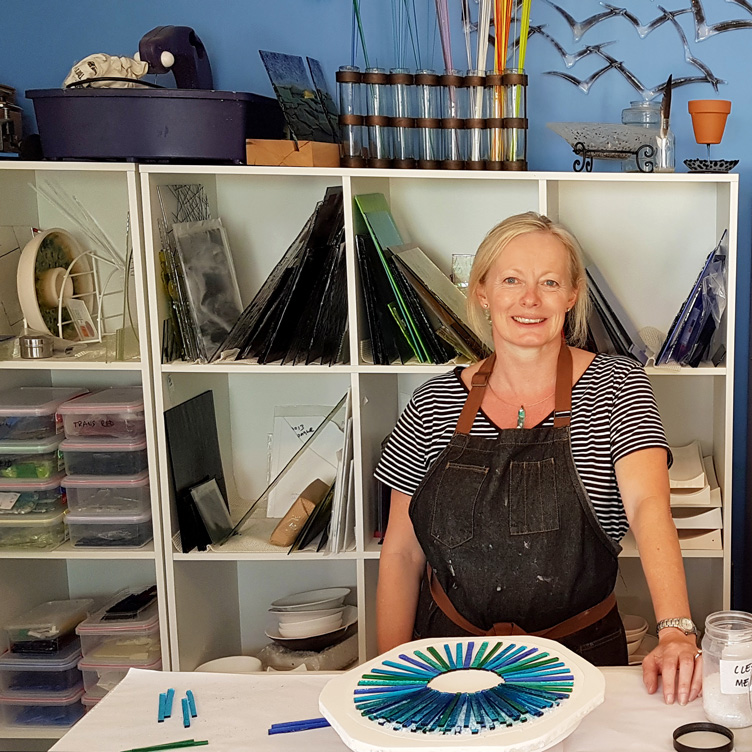

What do you make?
I design and produce decorative and functional fused glass items. I have a very diverse style, so create a wide range of work that includes practical dishes and bowls, decorative suncatchers as well as sculptural pieces of glasss art and wall art.
What exactly is fused glass?
When many people think of glass they think of glass blowing. Fused glass differs to blown glass because the glass isn’t handled in its molten state. Glass pieces are cut and assembled by hand, and other elements or embellishments added to the design. The glass is then put into a kiln which is programmed to heat up and cool down in a controlled manner, reaching temperatures of up to 800 degrees. During this process, which takes around 24 hours, the glass softens and fuses together into one piece. Most items require two to three separate firings, with subsequent firings using a combination of heat and gravity to shape the glass into bowls, dishes or platters.

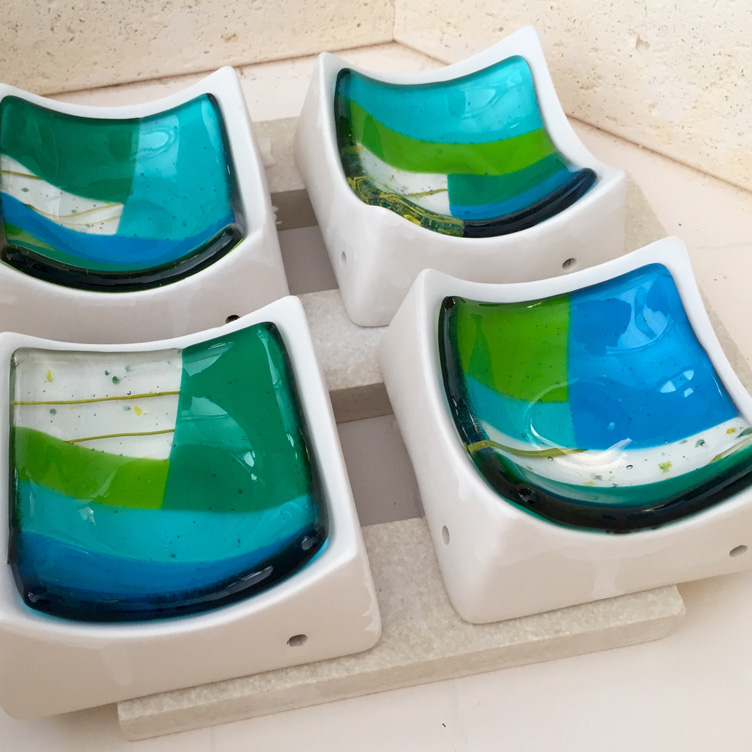
How did you get into your craft?
It all started with a garage clear out. I had whole cupboard of art and craft supplies that I’d brought from Scotland when I emigrated to New Zealand a decade ago that I rarely used, yet I couldn’t bear to part with them. It got me to thinking why? Why am I hanging onto all this stuff that I’m clearly never going to do anything with? I figured out, during a moment of clarity at 2am, that I had a creative itch that needed to be scratched, and that perhaps I hadn’t yet found the right medium to express my creativity.
So I decided to book some courses working with materials I’d not tried before. One of these was a one day glass fusing course in Wanganui. Glass appealed because it allowed me to express and create in a more abstract way, focusing on colour, light, composition, texture and form – a very different experience to painting and drawing which had always left me frustrated with the results.
After a day of playing with glass, cutting and assembling different designs, I was hooked! Following the course I purchased a small “microwave kiln” that fuses small pendant-sized pieces of glass in a microwave oven and started experimenting and learning. Six months later I resigned from my job and bought two second hand kilns on Trade Me. I named them Ritchie and Dan as like their namesakes they are reliable, a bit bashed and scratched around the edges, and very very hot!


Do you have formal training or qualifications in your craft?
My career was in marketing, so I don’t have any formal training in either art or fused glass. Apart from attending a couple of glass fusing courses I’m completely self taught with the help of books, YouTube and Facebook groups dedicated to glass fusing. I actually prefer to learn by trial and error as it can lead to new directions and “happy accidents” when items turn out different than expected, but in a good way! I keep records of every single firing I do in the kilns, documenting glass colours, techniques and firing schedules so I can refer back and tweak schedules as necessary.
Your favourite materials, tools and processes?
My favourite tools have to be my kilns! I have three of them, which might seem greedy, but each has its different uses. Ritchie is a ceramic kiln where the heating elements are around the edge of the kiln, so ideal for glass casting, firing my own ceramic molds, and higher temperature work over 930 degrees where the glass becomes molten and flows. The other two kilns are specifically designed for glass fusing as the heating elements are in the lid – this allows for a more even heat distribution over the surface of the glass so there is less chance of the glass breaking during heating. Dan is a small, round kiln so ideal for testing and one-off pieces that require a specific firing schedule. Robbie is the largest of the three kilns, so ideal for larger works or making multiple pieces at once. Each kiln has an electronic controller which controls how fast each kiln heats and cools, and how long to hold for at certain temperatures during the fusing process.
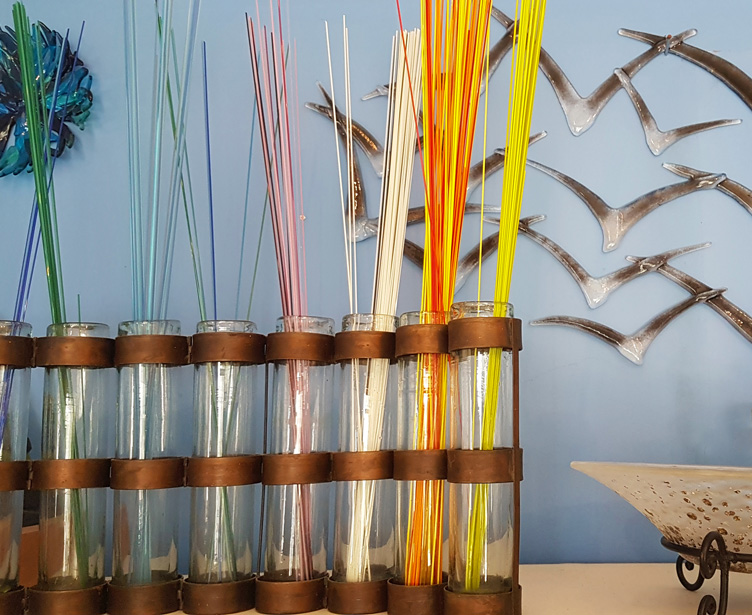
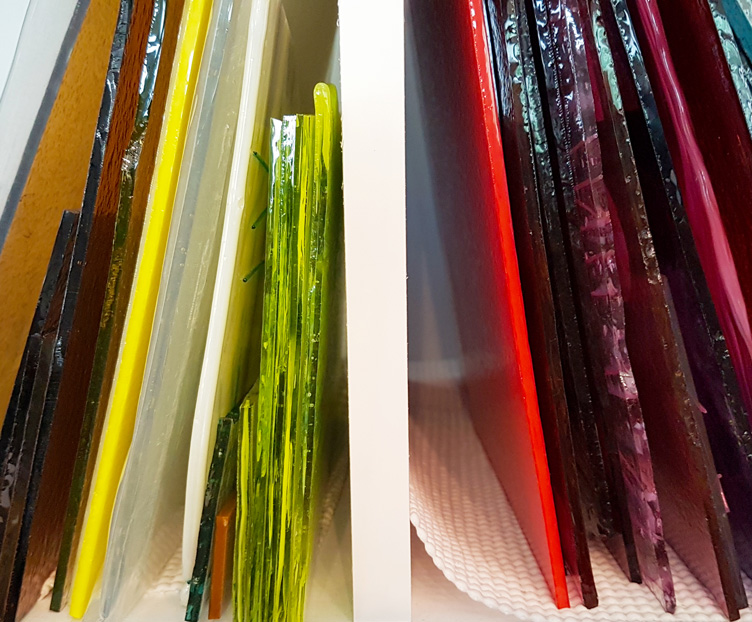

What glass do you use in your work?
All the glass I use is hand made in the USA by a family-owned company called Bullseye, and is designed specifically for use in glass fusing. Why do I import my glass I hear you ask? What’s wrong with using bottle glass or window glass in New Zealand? Here comes the technical bit: glass expands and contracts when heated and cooled, and different types of glass do so at different rates. So it’s not possible to combine window glass and bottle glass, or even two different types of bottles, as when the glass cools, one will contract faster than the other, which leads to stress in the glass, and it eventually cracking and breaking. So, because Bullseye’s glass is manufactured and tested for compatibility I can safely combine different colours of glass in one piece.
The glass I work with is glorious, and available in an amazing range of colours. Each sheet is handmade – a ladle of molten glass is dolloped onto a metal table then manipulated into a sausage shape before going through metal rollers to create a flat sheet. This sheet glass acts as my “canvas” for most projects. I then add more glass, glass stringers (think glass spaghetti) and crushed glass called frit which comes in a variety of sizes from coarse (like sea salt) down to fine powder. Depending on the project I’ll also use glass enamel paints, pure silver foil or mica too.
Tell us about some of the techniques involved in producing one of your pieces
For my sunbursts, I select four or five colours of glass that work well together and cut them into 160 narrow strips. Then the delicate work of constructing the sunburst begins. Crushed glass frit is added between the strips then the next layer of layer of strips and crushed glass is added. There can be up to 4 layers of glass, and it requires a very steady hand! Once in the kiln, it’s important to keep an eye on how the glass is fusing – too much time or heat and the sunburst loses definition and goes a bit blobby, not enough and it looks raw and unfinished. By fusing at a lower temperature than normal I manage to retain the texture of the strips but with gently rounded edges. Having the multiple layers overlapping creates a lens effect and lots of depth, and additional colours are created where different coloured glass strips have been laid on top of each other.

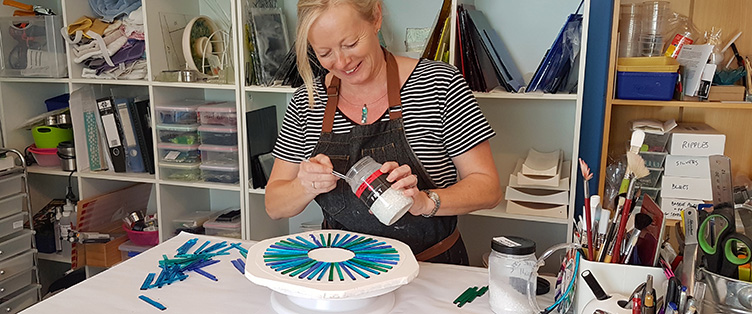
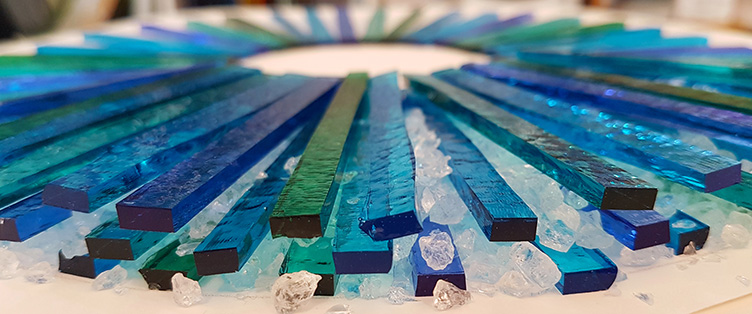
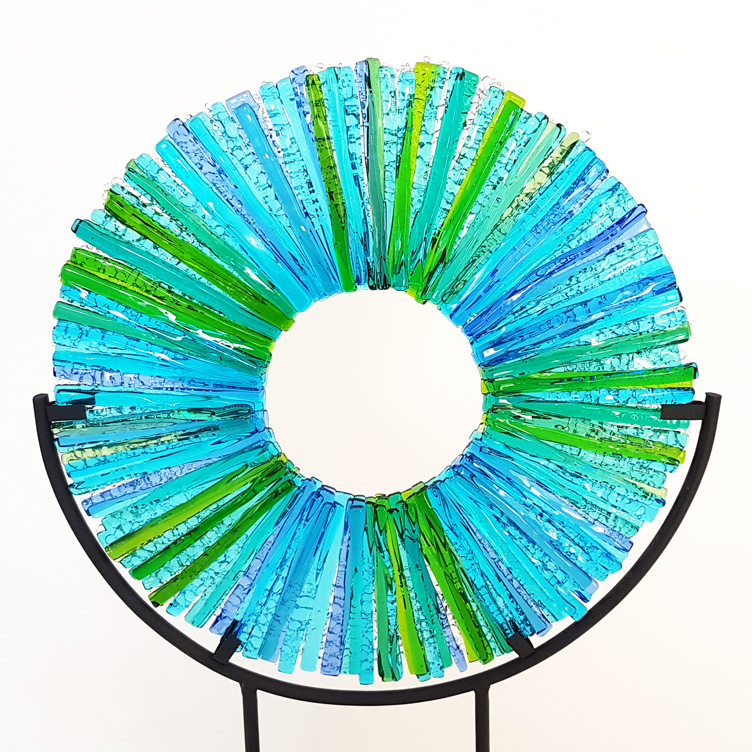
What inspires you?
I emigrated to New Zealand from Scotland in 2002, attracted by the lifestyle, climate and landscape. I still find myself stunned by the beauty around me; the ever changing weather patterns, the vast expansive landscapes and seascapes and the smallest details in pebbles, shells, feathers and ferns. It is this organic, natural essence of New Zealand that I aim to capture in my work.
Is there a philosophy behind your work?
Not so much of a philosophy, but more of a vision. (Once a marketeer, always a marketeer!) Because I am self taught and have no particular artistic background it was important to me when I started that I didn’t set myself lofty artistic goals that I couldn’t achieve. I wanted to be kind on myself as I learned, so my vision was (and is!) to create irresistibly pretty fused glass that makes people happy. And glass does have that effect on people – they light up when they see a piece they are drawn to.
Describe your creative process:
I regard myself as an intuitive artist as I’ll start with an idea and a selection of colours and play around with the glass layout and composition, adding and removing elements until I feel it looks right. Sometimes this will spark a different idea, and I end up creating something completely different! Once I start work on a piece I’ll often give it a name as that gives me guidance in terms of what it needs to come to life.
Describe your workspace:
A colourful oasis of chaotic creativity! It was formerly my husband’s games room attached to the garage. Only the beer fridge remains!
What’s your favourite thing about working with glass?
Working with glass involves a fascinating mix of art and science, so requires that I use both sides of my brain! It’s essential to understand how glass behaves at different temperatures in the kiln so I can achieve the desired result and I do lots of testing, trial and error and problem solving when working on new designs. It’s like Christmas every morning for me – I love opening the kiln and seeing how the glass has magically transformed overnight.
Have you ever cut or burned yourself?
Fortunately any cuts or nicks have been minor and fixed with a plaster. However I did burn my eyelashes off once when I peeked into an open kiln for a second too long! I only realised the next day when I went to put mascara on and discovered I only had stumps left!
Your favourite feedback from a customer:
Many of my pieces are purchased by visitors from overseas. I love it when they send me an email once they’re back home with a photo of their piece in pride of place!
A favourite quote:
“We must let go of the life we have planned, so as to have the life that is waiting for us.” – E.M. Forster.
What would your advice be for those starting out in a crafty business?
Make things you love, not things you “think” will sell. I believe every handmade item carries the essence of the artist, and if it’s made with money in mind, not love, then customers pick up on that.
What was the last handmade item you bought and what attracted you to it?
A bold, colourful child’s painting purchased from a school fundraiser. I love the freedom and lack of self consciousness in children’s art. I have it in my studio and it acts a reminder to let go, play and have fun with my glass.
What’s in store for 2018?
Most of my work is sold from my gallery in Nelson and through Felt. This year I would love to see my work in other shops and galleries around the country. I have had work accepted for the Royal Easter Show in Auckland and the Christchurch Art Fair this year though, which is exciting.
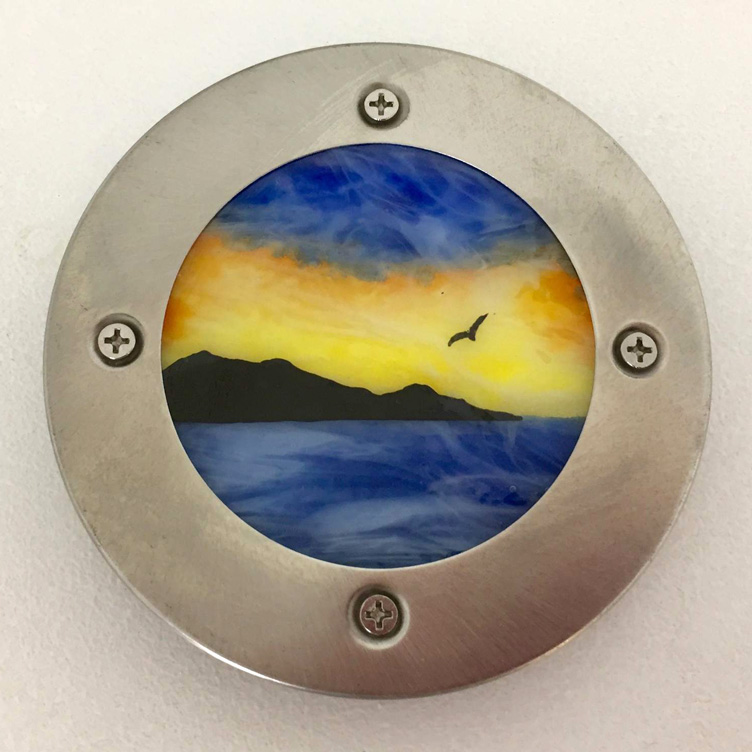

Prize draw! Special offer!
Roz has very kindly offered a gorgeous prize for one lucky Felt reader of a pair of these vibrant geometric ring dishes, made using five different shades of beautifully coloured glass, worth $60.00 (see below).
If you would like to be in to win, let us know what you enjoyed reading about Roz’s story and her Clarity Glass creations. The draw closes at 5pm on Monday 2 April and is open to New Zealand residents only.
And Roz is also offering free shipping on all purchases from Felt for the duration of her feature fortnight! To take advantage of this offer on your purchase from Clarity Glass, make sure you enter the code FREESHIP in the voucher code field at step 4 of checkout.
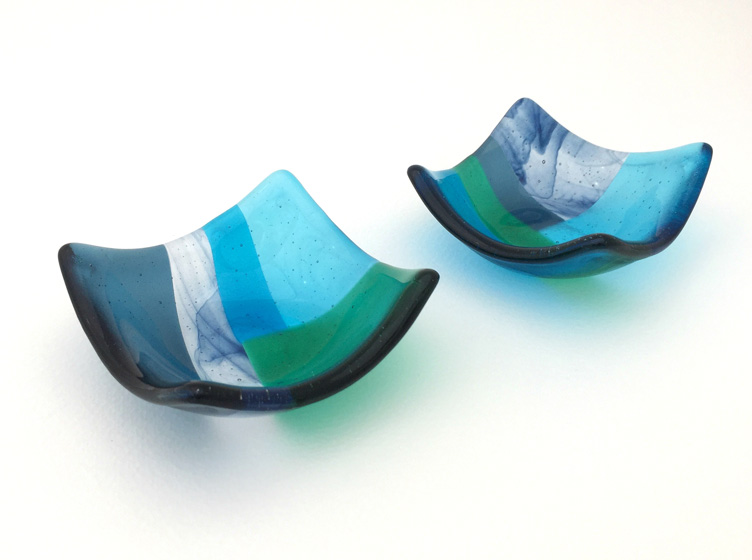

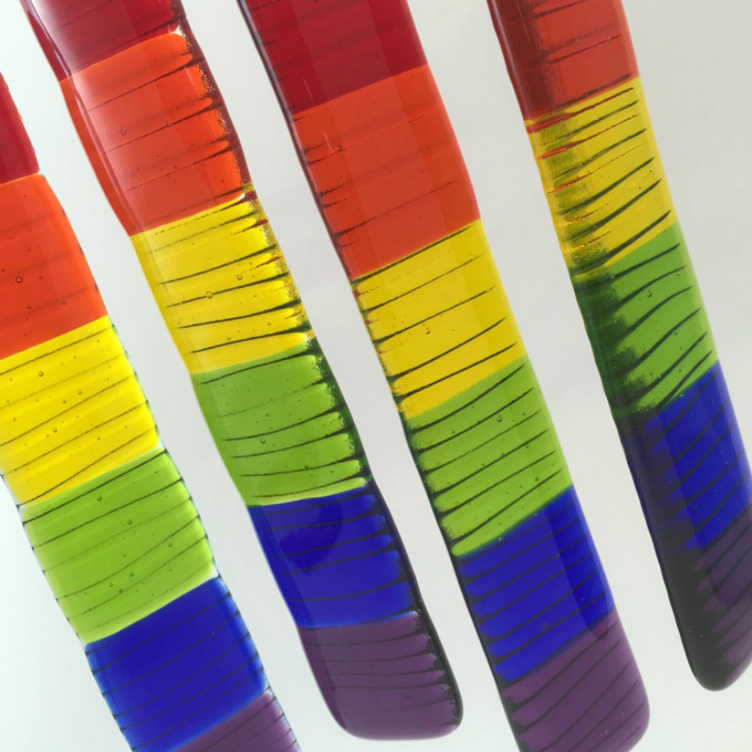
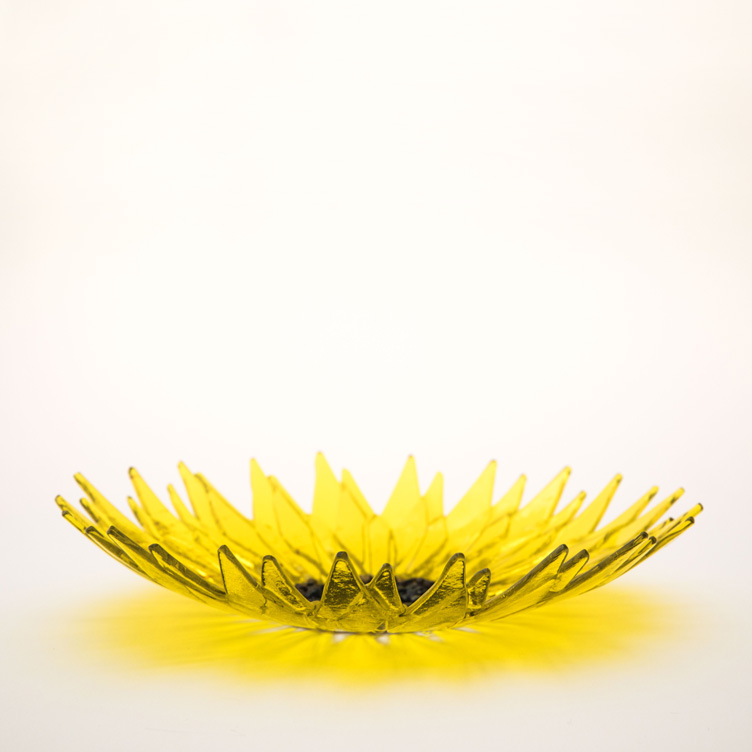

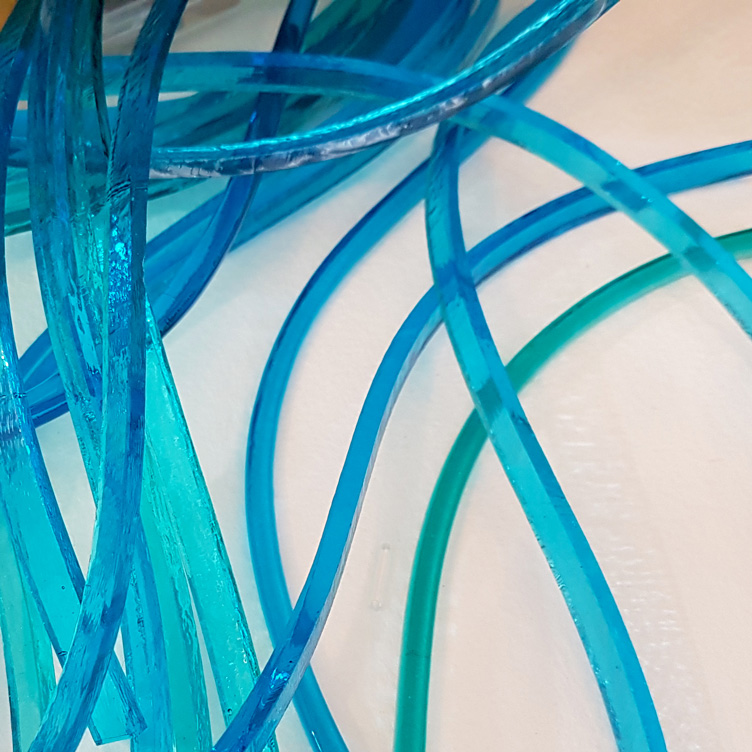






She is so so right when she says to make what you love, not what you think will sell. It is virtually impossible to predict what will sell. Sometimes obsure things have quirky value that mainstream items don’t. Good luck Roz, your work is beautiful!
I love the 2 am moment of clarity and the dedication to following the creative dream! What and inspiring story and such beautiful glass.
What a nice surprise to see a Nelson artist featured the first time I visit Felt. I moved to Nelson recently & I’ve seen & admired Roz’s work, I especially love the marine inspired pieces …it’s nice to hear some back ground on the artist. Nelson’s the perfect place for inspiration with its beautiful natural landscape & artists, like Roz everyone’s pretty happy to share their experiences & it’s easy to soak up their passion & joy in their work.
The quote. It is very timely for me as I navigate co-parenting 12 months after a break up. We must let go of the life we have planned, so as to have the life that is waiting for us.” – E.M. Forster.
It resonates with me and gives me hope and strength to get over this latest hurdle. Thank you. Your work is beautiful.
Woah! Tino ātaahua! I looooove the names of her kilns, classis. Also the vibrancy of each piece and her creative journey. Simply stunning pieces.
Wow i love the colours and vibrancy of the glass. Amazing work. As a mosaic artist I love working with glass myself.